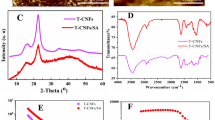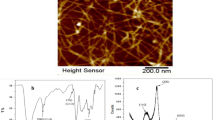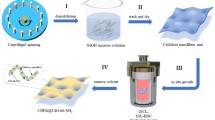Abstract
In this article, TEMPO-oxidized cellulose nanofiber (TEMPO-CNF) prepared from bagasse was described and utilized as a sustainable material for the preparation of new nanocomposites. TiO2 nanoparticles were synthesized by in situ precipitation in the presence of TEMPO-CNF. The prepared nanocomposite, TEMPO-CNF/TiO2, was characterized by using FT-IR, XRD, TGA, SEM, and EDX analysis. The results proved that homogenous spherical TiO2 nanoparticles were formed with the particles of TEMPO-CNF. TEMPO-CNF/TiO2 nanocomposite was examined as an adsorbent for Brilliant Blue (BB) adsorption. The highest BB removal efficiency was observed at pH 7, the adsorption process is well described by pseudo-second-order and Langmuir adsorption model, and the maximum adsorption capacity is 162 mg/g. Our results proved that the TEMPO-CNF/TiO2 nanocomposite could be used for the removal of BB from aqueous solutions.










Similar content being viewed by others
References
Niu P, Hao J (2011) Fabrication of titanium dioxide and tungstophosphate nanocomposite films and their photocatalytic degradation for methyl orange. Langmuir 27:13590–13597
Haque E, Jun JW, Jhung SH (2011) Adsorptive removal of methyl orange and methylene blue from aqueous solution with a metal-organic framework material, iron terephthalate (MOF-235). J Hazard Mater 185:507–511
Salama A (2018) Preparation of CMC-g-P(SPMA) super adsorbent hydrogels: exploring their capacity for MB removal from waste water. Int J Biol Macromol 106:940–946
Salama A, Shoueir KR, Aljohani HA (2017) Preparation of sustainable nanocomposite as new adsorbent for dyes removal. Fibers Polym 18:1825–1830
Salama A, Shukry N, El-Sakhawy M (2015) Carboxymethyl cellulose-g-poly(2-(dimethylamino) ethyl methacrylate) hydrogel as adsorbent for dye removal. Int J Biol Macromol 73:72–75
Salama A, Hesemann P (2018) Synthesis of N-guanidinium-chitosan/silica hybrid composites: efficient adsorbents for anionic pollutants. J Polym Environ 26:1986–1997
Monier M, Ayad DM, Wei Y (2010) Adsorption of Cu(II), Co(II), and Ni(II) ions by modified magnetic chitosan chelating resin. J Hazard Mater 177:962–970
Salama A, Etri S, Mohamed SAA (2018) Carboxymethyl cellulose prepared from mesquite tree: new source for promising nanocomposite materials. Carbohydr Polym 189:138–144
Manatunga DC, de Silva RM, de Silva KMN (2016) Natural polysaccharides leading to super adsorbent hydroxyapatite nanoparticles for the removal of heavy metals and dyes from aqueous solutions. RSC Adv. 6:105618–105630
Kumar ASK, Kalidhasan S, Rajesh V et al (2012) Application of cellulose-clay composite biosorbent toward the effective adsorption and removal of chromium from industrial wastewater. Ind Eng Chem Res 51:58–69
Wei X, Huang T, Yang JH (2017) Green synthesis of hybrid graphene oxide/microcrystalline cellulose aerogels and their use as superabsorbents. J Hazard Mater 335:28–38
Lavoine N, Desloges I, Dufresne A (2012) Microfibrillated cellulose—its barrier properties and applications in cellulosic materials: a review. Carbohydr Polym 90:735–764
Saini S, Sillard C, Naceur Belgacem M (2016) Nisin anchored cellulose nanofibers for long term antimicrobial active food packaging. RSC Adv. 6:12422–12430
Abo-uzeid RE, Khiari R, Beneventi D (2018) Biomimetic mineralization of three-dimensional printed alginate/TEMPO-oxidized cellulose nanofibril scaffolds for bone tissue engineering. Biomacromol 19:4442–4452
Abou-Zeid RE, Khiari R, El-Wakil N (2018) Current state and new trends in the use of cellulose nanomaterials for wastewater treatment. Biomacromol. https://doi.org/10.1021/acs.biomac.8b00839
Khalid A, Ullah H, Ul-Islam M (2017) Bacterial cellulose–TiO2 nanocomposites promote healing and tissue regeneration in burn mice model. RSC Adv. 7:47662–47668
Nsib MF, Hajji F, Mayoufi A (2014) In situ synthesis and characterization of TiO2/HPM cellulose hybrid material for the photocatalytic degradation of 4-NP under visible light. Comptes Rendus Chim. 17:839–848
Saito T, Uematsu T, Kimura S (2011) Self-aligned integration of native cellulose nanofibrils towards producing diverse bulk materials. Soft Matter 7:8804
Abou-Zeid RE, Dacrory S, Ali KA, Kamel S (2018) Novel method of preparation of tricarboxylic cellulose nanofiber for efficient removal of heavy metal ions from aqueous solution. Int J Biol Macromol 119:207–214
El-Gendy A, Abou-Zeid RE, Salama A, Diab M (2017) TEMPO-oxidized cellulose nanofibers/polylactic acid/TiO2 as antibacterial bionanocomposite for active packaging. Egypt J Chem 60:1007–1014
Hassan M, Berglund L, Hassan E, Abou-Zeid R, Oksman K (2018) Effect of xylanase pretreatment of rice straw unbleached soda and neutral sulfite pulps on isolation of nanofibers and their properties. Cellulose 25:2939–2953
Ngenefeme JF-T, Eko JN, Mbom DYA (2013) One pot green synthesis and characterisation of iron oxide-pectin hybrid nanocomposite. Open J Compos Mater. 03:30–37
Salama A, Neumann M, Günter C (2014) Ionic liquid-assisted formation of cellulose/calcium phosphate hybrid materials. Beilstein J Nanotechnol. 5:1553–1568
El-Kemary MA, El-mehasseb IM, Shoueir KR, El-Shafey SE, El-Shafey OI, Aljohani HA, Fouad RR (2018) Sol–gel TiO2 decorated on eggshell nanocrystal as engineered adsorbents for removal of acid dye. J Disper Sci Technol 39:911–921
Monier M, Abdel-Latif DA (2012) Preparation of cross-linked magnetic chitosan-phenylthiourea resin for adsorption of Hg(II), Cd(II) and Zn(II) ions from aqueous solutions. J Hazard Mater 209–210:240–249
Mohammadi A, Karimi AA (2017) Methylene blue removal using surface-modified TiO2 nanoparticles: a comparative study on adsorption and photocatalytic degradation. J Water Environ Nanotechnol. 2:118–128
Zhao R, Wang Y, Li X (2015) Synthesis of β-cyclodextrin-based electrospun nanofiber membranes for highly efficient adsorption and separation of methylene blue. ACS Appl Mater Interfaces 7:26649–26657
Ma J, Yu F, Zhou L (2012) Enhanced adsorptive removal of methyl orange and methylene blue from aqueous solution by alkali-activated multiwalled carbon nanotubes. ACS Appl Mater Interfaces 4:5749–5760
Khoshhesab Z, Gonbadi K, Behbehani G (2015) Removal of reactive black 8 dye from aqueous solutions using zinc oxide nanoparticles: investigation of adsorption parameters. Desalination and Water Treatment 56:1558–1565
Langmuir I (1918) The adsorption of gases on plane surfaces of glass, mica and platinum. J Am Chem Soc 40:1361
Freundlich HMF (1906) Over the adsorption in solution. J Phys Chem 57:385–470
Salama A (2017) New sustainable hybrid material as adsorbent for dye removal from aqueous solutions. J Colloid Interface Sci 487:348–353
Wang Y, Wang H, Peng H (2018) Dye adsorption from aqueous solution by cellulose/chitosan composite: equilibrium, kinetics, and thermodynamics. Fibers Polym. 19:340–349
Mohammed N, Grishkewich N, Berry RM (2015) Cellulose nanocrystal–alginate hydrogel beads as novel adsorbents for organic dyes in aqueous solutions. Cellulose 22:3725–3738
Salama A (2016) Functionalized hybrid materials assisted organic dyes removal from aqueous solutions. Environ Nanotechnology, Monit Manag. 6:159–163
Geng Qijin, Cui Wenwen (2010) Adsorption and photocatalytic degradation of reactive brilliant red K-2BP by TiO2/AC in bubbling fluidized bed photocatalytic reactor. Ind Eng Chem Res 49:11321–11330
Acknowledgements
The authors extend their appreciation to Dr. Ragab Abou-Zeid from Cellulose and Paper Department, National Research Center, for supporting this work through preparation of CNF.
Author information
Authors and Affiliations
Corresponding author
Ethics declarations
Conflict of interest
The authors declare that they have no conflict of interest.
Additional information
Publisher's Note
Springer Nature remains neutral with regard to jurisdictional claims in published maps and institutional affiliations.
Rights and permissions
About this article
Cite this article
Al-Ahmed, Z.A., Hassan, A.A., El-Khouly, S.M. et al. TEMPO-oxidized cellulose nanofibers/TiO2 nanocomposite as new adsorbent for Brilliant Blue dye removal. Polym. Bull. 77, 6213–6226 (2020). https://doi.org/10.1007/s00289-019-03068-4
Received:
Revised:
Accepted:
Published:
Issue Date:
DOI: https://doi.org/10.1007/s00289-019-03068-4




